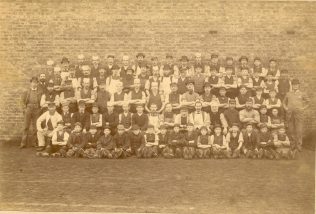The hesitant beginnings of Stead McAlpin


Rural beginnings
Stead McAlpin has its roots not in Cummersdale but 12 miles away in Wigton.Thomas McAlpin was born at Old Carlisle, the eldest child of Hugh and Martha McAlpin. Old Carlisle is a Roman settlement two miles from Wigton. He and his brothers Duncan, William and Thomas all became Calico printers – probably trained in Wigton. Thomas had one son (Edward) from his first marriage to Jane Livock. In 1827, after being widowed in 1822, he married Mary Stead. She had two sons from her first marriage, John who kept the name Stead, and Nathan who took the name Stead McAlpin.
Fire
The printworks at Wigton was probably established in 1790. By 1821 it was known as Messrs Ferguson Halliley and Co and was managed by Richard and Anthony Halliley and and Thomas McAlpin. A Halliley and Co were bankrupt by 1847 following a fire on Christmas Eve 1845. The closure and loss of jobs had an effect on weaving, retail and the alehouses. Tradition has it that some twenty-one printers and seven indigo pencillers packed up all their belongings and walked, with their families, from Wigton to their new place of work.
No mill-ing around
In 1801, premises were built by a group of businessmen under the leader William Forster a wealthy banker from Carlisle. The works had produced printed cotton dress fabric until 1817. Thomas McAlpin took the lease of the mill from William Forster in 1835. Incidentally Foster placed the first printing block when the works had their grand reopening in June of that year. The works were in need of renovation, alteration and addition.
Entire refit
The most exciting element of the renovation was the installation of the four-colour copper roller printing machine which cost £200, part of an entire refit bill of £1,300. These rollers were manufactured and engraved in Manchester, 120 miles away, and transported at that time by wagon and horse. Copper roller printing in one form or another continued until 1970. The ancient craft of block printing was also used at the site until 1977. In 1844 William Forster became bankrupt and so the company took the opportunity to purchase the works outright from their landlord’s receivers.
McAlpin, Stead & Co
The Company was known as Thomas McAlpin and Sons, subsequently Thomas McAlpin & Co and after the death of McAlpin in 1849 McAlpin, Stead & Co. A London office was set up very early on to deal with orders and wholesale in the capital.





No Comments
Add a comment about this page